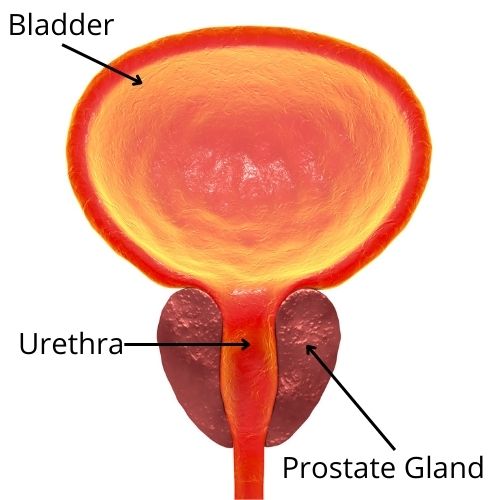Prostate Cancer is the second leading cause of cancer deaths in American men and the 5th leading cause of cancer deaths.
Black men in particular experience the highest rates of prostate cancer (183.4 per 100,000 people vs. 112.7 for all races combined).
In order to fight this disease, it’s important to educate ourselves and others about common risk factors, symptoms, and prevention strategies.
What is the Prostate?

The prostate is a small gland in men that secretes fluid that nourishes and protects sperm.
It is located just below the bladder in front of the rectum and wraps around the urethra which carries urine and semen out of the body.
The prostate tends to grow larger as you get older. If your prostate gets too large, it can cause a number of health issues including prostate cancer.
Prostate Cancer at a Glance

Prostate cancer develops in the prostate gland and can be hard to detect since it typically causes no symptoms in its early stages.
The good news is that the five-year survival rate is high (96.8%) if it is detected and treated early.
In fact, there are more than 3.1 million American men who have been diagnosed with prostate cancer at some point in their lifetime still alive today.
Let’s get into some other important statistics to know.
- 1 in 8 U.S. men will receive a prostate cancer diagnosis at some point in their lifetime.
- Having a brother with prostate cancer increases a man’s risk of developing the disease more than having a father with it.
- Men over the age of 65 receive nearly 60% of all prostate cancer diagnoses in America.
- An American man dies from prostate cancer every 15 minutes.
- The five-year survival rate drops from 98% to 31% when advanced prostate cancer spreads to bones, organs, or distant lymph nodes. (ZeroCancer.org)
Common Risk Factors for Prostate Cancer

As the statistics above show, diagnosis and death rates are overall higher in men over the age of 65, men with a family history of the disease, and Black men.
Men who have been exposed to asbestos, men with BRCA1 or BRCA 2 genetic mutations, and men who live in certain geographic areas are also at increased risk.
Eating eggs and red meat can even increase a man’s risk of prostate cancer.
Prostate Cancer Symptoms

Prostate cancer does not typically cause symptoms in its early stages — meaning it can be somewhat of an “invisible” cancer.
More advanced cases, however, can cause symptoms such as:
- Trouble urinating
- Urinating often
- Blood in the urine or semen
- Painful ejaculation
- Pain in the hips, back, or pelvis
If you or a loved one are experiencing any of these symptoms, schedule a screening with your doctor right away.
Prostate Cancer Prevention Tips

Of course, there is no guarantee that you won’t develop prostate cancer, but there are some things you can do to help lower your risk.
Most of these precautions involve lifestyle changes, such as:
- Maintaining a healthy body weight
- Eating a balanced diet with plenty of anti-inflammatory foods, including fish, berries, green leafy vegetables, nuts, and olive oil
- Limiting your calcium intake, as high amounts have been shown to increase the risk of aggressive prostate cancer
- Staying physically active
And depending on your age and other risk factors, consider getting screened.
When To Get Screened for Prostate Cancer

Screenings aim to identify cancer cells before they spread — and the earlier cancer is detected, the higher the chances are of successful treatment.
Digital rectal exams (DRE) are a common screening method for prostate cancer.
Men identify the discomfort associated with DREs as one of their top fears when discussing prostate cancer.
And while this is a valid fear, it’s still important to take control of your health to improve your outcomes, especially if you fall into a high-risk category.
The American Cancer Society (ACS) recommends that men get a prostate screening based on the following criteria:
- Age 50 for men at average risk of prostate cancer
- Age 45 for men at high risk of prostate cancer (including Black men and those with a first-degree relative diagnosed before age 65)
- Age 40 for men at even higher risk (specifically those with two or more first-degree relatives who had prostate cancer at an early age)
While this information might seem scary, there is hope — especially if the cancer is detected early.
Use these statistics as a resource to educate yourself and other men in your life, and take control of your health.
Follow Mocha Man Style on our Social Channels

Frederick J. Goodall is the Editor-in-Chief of Mocha Man Style, media spokesperson, event host, photographer, and a top social media influencer in Houston, TX. He likes to write about fashion, cars, travel, and health.

